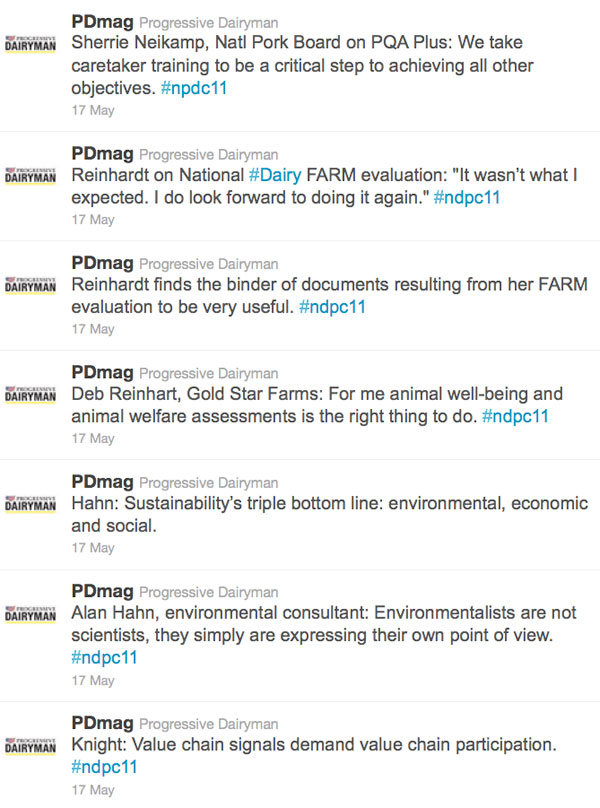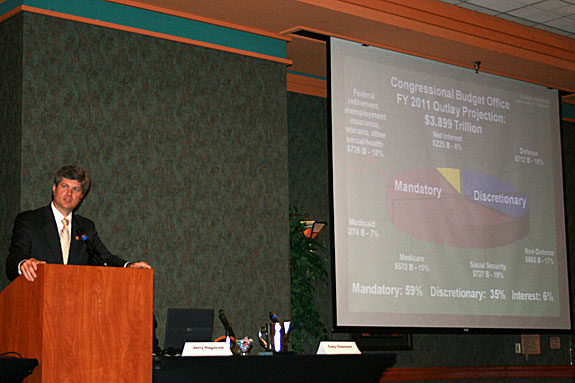As the spring track and field season comes to a close, the equipment is gathered and locked away while students depart on a much-needed break. Unfortunately for dairy producers, their hurdles remain in place. At the National Dairy Producers Conference this May in Omaha, Nebraska, speakers from across the country reported on the conditions that lie ahead for the dairy industry. From Capitol Hill and foreign trade to high input costs and animal care, the gamut of issues was run. Capitol Hill U.S. Representative Jeff Fortenberry of Nebraska’s 1st Congressional District welcomed everyone to his home state and briefed the audience as to what has been happening on the Hill.
He reported, the initial deficit of the country’s fiscal year 2011 budget was at $1.2 trillion, but a new estimate puts it at nearly $1.7 trillion. “We have to tighten the belt and share in the sacrifice,” Fortenberry said.
The representative went on to say that the Farm Bill would not be passed this year. Groundwork for it is being done, but budgetary constraints are taking the majority of Congress’ time.
Even though many in agriculture would like to see a carbon copy of the 2008 bill, Mary Kay Thatcher with the American Farm Bureau Federation, said that is unlikely.
“The high commodity prices are working against us,” she said. “Congress believes every single farmer is rich.”
With the nation’s deficit worse now than any other farm bill year and funding already removed from the 2008 bill to assist the current budget issues, less money will be available to spend this time.
Cory Claussen, staff member for the Senate Ag Committee agreed, “We can’t do a straight extension of the farm bill. The money’s not there.”
According to Thatcher, 37 programs in the current farm bill will have no baseline after 2012. Legislators from those constituencies will seek to acquire that funding from elsewhere in the bill.
“It’s a really hostile environment,” Claussen said. “There are a lot of new folks up on the Hill that are ideological. Your job is to get in touch with your senators and representatives to bang that drum.
“There is a lack of understanding of farm programs – not just the senators and representatives, but also their staff members. You have to start from the ground up. Explain what a dairy farm is and what it is you [as farmers] do.
“I know everyone wants to move this very quickly, but we have a lot of education to do,” he concluded.
Dairy policy
Representatives from four dairy producer groups, including Geoff Vanden Heuvel, Milk Producers Council; Hank van Exel, Holstein Association USA; Bob Naerebout, Idaho Dairymen’s Association; and Bill Rowell, Dairy Farmers Working Together; weighed in on current and potential dairy policy options. Primarily they focused on National Milk Producers Federation’s Foundation for the Future (FFTF) plan.
“Status quo doesn’t work. We don’t like where we are [under the current policies],” Rowell stated in a sentiment that was echoed by all other panelists. Each of them also recognized that the industry must agree in order to move forward.
“There are pieces of Foundation for the Future that we really like and there are pieces we need to support to get the help we need,” Naerebout said of his group’s decision to get behind it. “We thought it was important for the industry as a whole to put down the smaller pieces we don’t agree with and push it forward.”
Trade
“Moving from net importer to net exporter in the last decade demonstrates [U.S.] dairy is ready to complete globally,” stated Jim Murphy, former assistant U.S. Trade representative. “Clearly the world has changed and the U.S. dairy industry is taking advantage of it.”
Dalyn Dye of Hoogwegt U.S., Inc., said he believes we are just scratching the surface of U.S. dairy products being consumed worldwide. There is tremendous opportunity with infant foods and food service chains “westernizing” diets in other countries.
To capture this, Dye said, “We need to shift our mindset in terms of exports versus domestic customers and think of these markets as all global customers.”
Showing the swing in milk prices over the last decade for the U.S., European Union, New Zealand and Canada, he said, “Being able to control volatility is a myth. Volatility is a function of the larger global market. When the world booms and the world busts – so will go us.”
The larger opportunity lies in learning to manage volatility and this is where he perceives the U.S. dairy producer has an advantage over other countries.
High input costs
Not only will dairy producers have to manage milk price volatility, but also the volatility in input prices.
“The No. 1 thing we have to do is make a plan,” said Ed Gallagher, Dairy Risk Management Services, a division of Dairy Farmers of America, Inc. “I think it pays to spend the time making the plan. In 2008 some farmers with a plan saved $5, $6, $7, $8 per hundredweight.”
Gallagher added the best hedge on feed prices a producer can have is to own your land and grow your feed.
Through economic modeling, Professor Bruce Babcock at Iowa State University determined that with an average yield for corn in 2011 the average price for 2012 could be $5.12 per bushel. A disaster year could result in $8 corn and a bumper crop could have prices at less than $3 per bushel.
Babcock also noted that the amount ethanol subsidies impact the corn price is modest. The average impact over the last five years was 14 cents per bushel. Including the industry’s expansion and demand for corn, the total average impact of ethanol was just 74 cents per bushel.
A byproduct of the ethanol industry – distillers grains – has been used by some producers to offset the increasing price of corn. Dr. Gordie Jones of Central Sands Dairy, LLC, says he uses it and that it does work as a substitute, however the quantity the cow can adequately digest is limited.
“The secret is better forages,” Jones said. If we cut hay early; if we cut corn silage right; we don’t have to buy $8 corn.”
Environmental stewardship
Bruce Knight, former National Resources Conservation Services chief and USDA undersecretary said today’s environmental opportunities come down to research, renewables, and conservation and sustainability.
He stated, “Sustainability has moved from a philosophical objective to an economical one.” Most of its value today lies in efficiency measures such as energy audits, precision placement technologies and biotechnology.
Environmental consultant Alan Hahn of Dragun Corporation, said farms need to continue to embrace technology, assume population productions, and embrace voluntary and involuntary environmental pressures.

Animal care
From the retail side, Margaret Standing, director of corporate communications for Bob Evans, explained how the company is handling discussions of animal welfare. In order to comfortably engage in conversations with customers, suppliers, retailers and activist groups, Bob Evans joined the Coalition for Sustainable Egg Supply and created an animal well-being committee.
Based on recommendations from the committee, Bob Evans requires all suppliers to submit animal care/welfare policies to the company on an annual basis. It also created an animal care mission statement and continues to engage and work closely with animal care experts.
Standing said the company acknowledges its “policies and programs should be ethically grounded, scientifically verified and economically viable.”
Bob Evans uses its website, social media and trained restaurant managers to communicate its position on animal welfare to inquiring customers.
Wisconsin dairy producer Deb Reinhart shared her perspective of the producer side of animal welfare. Last spring, her farm underwent an evaluation through the National Dairy FARM Program.
“For me animal well-being and animal welfare assessments is the right thing to do,” Reinhart said.
She mentioned there is more work to be done with the program, but stressed it is a process with continual education required both for and from dairy producers.
“It wasn’t what I expected, not that I really knew what I expected,” she said. “I do look forward to doing it again.”
There is certainly more laps in store for dairy producers and only time will tell if these hurdles will be removed and stored or remain for the long haul. PD
PHOTOS
TOP RIGHT: U.S. Representative Jeff Fortenberry (R-Nebraska) outlines the nation’s budget problems for attendees of the National Dairy Producers Conference held in his home state. Photo by PD Editor Karen Lee.
BOTTOM RIGHT: PD Editor Karen Lee tweeted live from the conference. Rollover the image to see some of the updates she provided.

-
Karen Lee
- Progressive Dairyman Midwest Editor
- Email Karen Lee




